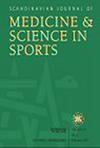90名职业足球运动员连续10个赛季的肌肉损伤:两种分类系统的比较及其与恢复比赛时间的关系
IF 3.8
2区 医学
Q1 SPORT SCIENCES
引用次数: 0
摘要
英国田径肌肉损伤分类(BAMIC)和慕尼黑共识声明(MCS)都是近年来建立的常用的分类系统,用于对肌肉损伤进行分类和估计恢复比赛时间(RTP)。MCS根据临床和放射学评估对损伤进行分类,而BAMIC主要依赖于放射成像,但也考虑到肌腱受累。然而,对于哪种分类更适合评估急性肌肉损伤及其与RTP的关系尚无共识。本研究的目的是比较BAMIC和MCS在职业足球运动员急性肌肉损伤中的RTP,并在背景方法不同的情况下确定影响退役时间的其他球员特征。在90名职业足球运动员中,平均在受伤后2.3天内对急性肌肉损伤进行169次MRI扫描(3特斯拉),并使用BAMIC和MCS进行评估。比较两种分类系统的分级,并与RTP进行相关性分析。进一步评估球员的信息,如损伤复发、优势腿、患侧、年龄或季节分布。两种分类系统的分级均与RTP相关(BAMIC: r = 0.533, p < 0.001; MCS: r = 0.583, p < 0.001)。与肌筋膜损伤(平均14.17天,中位数26.5;范围3-181;IQR = 25.3; CI = 20.2-38.5)和肌腱损伤(平均17.99天,中位数26.5;范围3-181;IQR = 25.3; CI = 20.2-38.5)相比(p = 0.002),腱膜内损伤的阻滞时间明显更长(平均38.61天,中位数26.5;范围3-181;IQR = 25.3; CI = 20.2-38.5)。9月(n = 22, 13.0%)和4月(n = 20, 11.8%)肌肉损伤显著增加(p < 0.001)。优势侧与患侧无相关性(p = 0.476)。两种分类系统都提供了与估计RTP相似的关联。考虑BAMIC分类的肌腱损伤被证明是特别重要的,因为RTP可以延长。不过,使用方式可能仍是个人选择。应更多地强调在季节开始和结束时的再生和预防,以减少高发病率。本文章由计算机程序翻译,如有差异,请以英文原文为准。
Muscle Injuries in 90 Professional Football Players Over 10 Consecutive Seasons: A Comparison of Two Classification Systems and Their Association With Return-to-Play Time.
The British Athletics Muscle Injury Classification (BAMIC) and the Munich consensus statement (MCS) are both commonly used classification systems and have been established in recent years to categorize muscle injuries and estimate return-to-play time (RTP). While the MCS classifies injuries based on clinical and radiological assessment, the BAMIC primarily relies on radiological imaging but also takes tendon involvement into account. However, there is no consensus on which classification is better suited for the assessment of acute muscle injury and its association with RTP. The aim of this study was to compare BAMIC and MCS in acute muscle injury of professional football players regarding RTP and to identify other player characteristics that influence the layoff time, given the fact that background approaches differ. In 90 professional football players, 169 MRI scans (3 Tesla) of acute muscle injuries were performed on average within 2.3 days of injury and assessed using the BAMIC and MCS. Grading of both classification systems was compared and correlated with RTP. Further player information, like recurrence of injury, dominant leg, affected side, age, or seasonal distribution, was evaluated. The grading of both classification systems correlated with RTP (BAMIC: r = 0.533, p < 0.001; MCS: r = 0.583, p < 0.001). Intratendinous injuries showed significantly longer layoff times (mean = 38.61 days, median = 26.5; range = 3-181; IQR = 25.3; CI = 20.2-38.5) compared to myofascial (mean = 14.17, median = 26.5; range = 3-181; IQR = 25.3; CI = 20.2-38.5) (p < 0.001) and myotendinous lesions (mean = 17.99, median = 26.5; range = 3-181; IQR = 25.3; CI = 20.2-38.5) (p = 0.002). The months of September (n = 22, 13.0%) and April (n = 20, 11.8%) showed significantly higher numbers of muscular injuries (p < 0.001). No association between the dominant side and affected side could be found (p = 0.476). Both classification systems provided a similar association with estimated RTP. The consideration of tendon injuries as classified in the BAMIC proves to be particularly important, as extended RTP can be expected. Still, usage might remain an individual choice. More emphasis should be placed on regeneration and prevention at the beginning and the end of the season to reduce the high incidences.
求助全文
通过发布文献求助,成功后即可免费获取论文全文。
去求助
来源期刊
CiteScore
7.90
自引率
4.90%
发文量
162
审稿时长
3 months
期刊介绍:
The Scandinavian Journal of Medicine & Science in Sports is a multidisciplinary journal published 12 times per year under the auspices of the Scandinavian Foundation of Medicine and Science in Sports.
It aims to publish high quality and impactful articles in the fields of orthopaedics, rehabilitation and sports medicine, exercise physiology and biochemistry, biomechanics and motor control, health and disease relating to sport, exercise and physical activity, as well as on the social and behavioural aspects of sport and exercise.

 求助内容:
求助内容: 应助结果提醒方式:
应助结果提醒方式:


